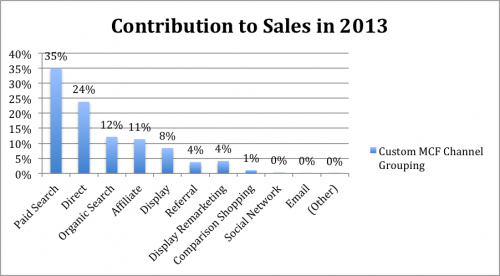Small and mid-sized eCommerce retailers face many challenges online. As a marketer, I’m drawn to three primary areas of interest:
- How to help online retailers keep pace with evolving sales channels, e.g. search landscape, social developments, mobile design, and optimization.
- How to help online retailers keep growing and increase revenue from non-paid sources.
- How to help online retailers engage their customers with quality content from first interaction to checkout.
1) Keeping up with evolving sales channels by understanding business strengths
Keeping pace with new and evolving sales channels demands resources. For many SMBs with limited budgets, this can be difficult to sustain — especially if ground is gained slowly and ROI is nonexistent. Businesses struggling to establish their brands and those that aren’t strong in any one particular sales channel tend to feel this challenge even more.

Many retailers assume they need to launch new brand expansion strategies all the time. But there are usually plenty of opportunities to improve and capitalize on current initiatives — especially with regards to non-paid channels. Retailers should determine the most efficient sales channels, and then work on maximizing those channels before moving on to the next initiative.
It can be quite difficult to convince a business bent on multiple initiatives to adopt a philosophy of mastering one lead channel at a time. But too many concurrent efforts spread resources too thin. Don’t worry about every channel. Instead, work to understand how each of your current sales channels contributes to your total market share, and then optimize how resources are allocated to those channels based on their contributions to your overall revenue.
For many retailers, this comes down to analyzing the customer journey and identifying the overall contribution of each channel to a sale. Consider the following scenario:
The above chart uses multi-channel funnels in Google Analytics. It measures the total contribution for each of the primary sales channels by looking at both “assists” and “last-touch” conversions. So what does that mean?
Customers rarely come to your site via only one channel (such as paid search), and then buy something immediately. More commonly, a customer may come to your site, buy nothing, and then return through another channel to purchase another day. This is especially true for more expensive products. Plus, as you develop customer relationships, you may engage with loyal customers over multiple channels over time.
Looking at “assists” and “last-touch” conversions allows you to account for the many ways you interact with your customers. A sales “assist” means that the channel appeared somewhere in a customer’s conversion path, but was not the visit in which the customer actually purchased. “Last-touch” refers to the visit in which the customer actually bought. For example, say a customer finds you through paid search, clicks to your site, signs up for a newsletter, and then leaves. You then email that customer. She returns via that email and purchases:
- Paid search receives a conversion “assist.”
- Email receives a “last-touch” conversion.
For the chart above, I created fake data for a nonexistent online store. But the channel percentages represent common channel distributions I’ve seen in real life.
Now let’s analyze the data for this fake eCommerce site. Looking at the graph, we can clearly see that neither social nor email drove sales in 2013 — neither assists nor actual conversions. Therefore, it may not be wise to depend on these channels to drive increases in sales in 2014. That doesn’t mean these channels aren’t useful for other purposes. Consider other goals besides sales for these channels, and then allocate resources according to the priority of those goals.
This may be in direct conflict with the views of those who want to see improvements in these programs. However, time could be better spent improving other channels that generate revenue, which could then literally pay the way for future experiments in social channels down the road.
2) Increasing revenue from non-paid sources
Looking back at the same graph above, we see that while paid search appears to be the highest contributor to sales, there is opportunity to increase the total contribution of all non-paid channels. That’s particularly true of organic search. SEO pros understand that gains in organic search tend to raise other non-paid programs, including direct. Therefore, a good strategy for this ecommerce business may be to focus efforts on improving organic search’s total contribution. Doing so will likely cut into the total contribution of paid search and affiliate channels. That could be a good thing, since it would save money. Perhaps the money saved there could go into research and experiments in other channels, like social and email.
But let’s dive even deeper here. This ecommerce site needs a strategy to improve organic search. Looking at this chart again I would go directly to the paid search team to understand their strategy. I would come prepared with a series of questions like:
- What can be leveraged from this channel and applied directly to the organic channel? For example, there could be an opportunity to improve organic positioning for keywords performing well in paid search. Perhaps there are keywords performing well organically (in terms of traffic and/or conversion rates) that can be scaled back on the paid search side.
- What is the strategy behind bidding on branded keywords? Assuming this site is ranking well organically for branded keywords, does it make sense to pull back in paid search?
- Is the company allowing affiliates to bid on brand keywords?
If in fact this retailer were to decide to make organic search a higher priority in 2014, they should want to understand the overall content strategy and perform a content ranking gap and opportunity analysis in particular. Ranking gaps refer to content that’s not ranking ideally for targeted terms. Ranking opportunities refer to situations where there are keywords and concepts to target but there is not adequate content. A thorough content audit can help uncover these gaps and opportunities.
3) Increasing customer engagement with quality content
A flexible content strategy can complement and enhance every sales channel. For this to work properly, channel managers must collaborate. For our example retailer, I would begin looking at how all the sales channels interact with one another. Common patterns should begin to emerge with regards to how customers interact with the channels and make their ways through the site. This will help to identify primary markets. I would then lay out content on the site and via sales channels based on how much I think that market contributes to overall sales. I would choose the channels based on which channel is best suited to reach that market.
The content strategy needs to be optimized for organic search, and therefore take into account all levels of target market interests – obviously optimized for major keywords and concepts. It should also be built to maximize a social distribution strategy and include thoughtful and intentional internal links that guide users through the site and through the purchase funnel.
Here’s one way this retailer could set this up:
- Focus on creating a structured and well-optimized eCommerce website where they are establishing various testing strategies making incremental improvements that increase user experience and bottom-line growth, i.e. sales from all channels.
- Establish a top funnel and middle funnel content strategy to drive interest and qualified traffic through the content pages and into the category/product pages – especially those that convert to sales.
There are so many ways to develop a content strategy and each is specific to the eCommerce business. The content strategy helps flesh out new email and social campaigns that can resonate with the target market. This will help make them more effective long-term and in 2015, this business could see that overall contribution from these channels increased in 2014 just by improving the content strategy and ensuring all sales channels work together more consistently.





